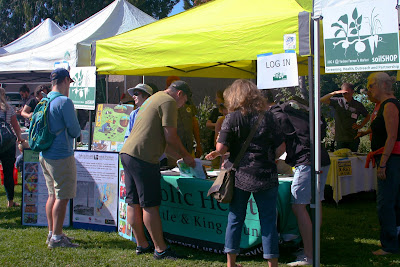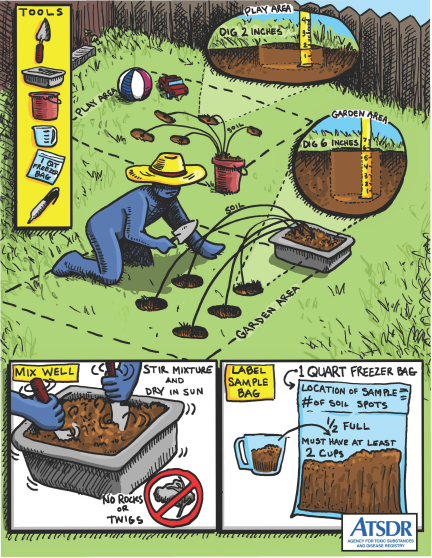 |
| Residents visiting the 2018 soilSHOP booth at the Vashon Farmer's Market |
Public Health Seattle King County and Ecology have teamed up to offer soilSHOP – a quick, easy, and anonymous way for residents to get their soil tested. Using handheld scanners, we will test soil samples that residents bring and provide instant analysis of arsenic and lead in the soil. As an added incentive, the first 15 soil-sampling participants will also receive a complimentary 30-pound bag of King County GroCo compost.
Vashon–Maury Island, while a beautiful place to live, is located downwind from the former Asarco Smelter site in Tacoma. Because of this, many properties have heavy metal contamination from the smelter.
Instant soil testing
 |
| Testing soil using XRF scanners |
The results of the XRF scan can help educate residents and property owners about soil contamination.
Staff will be available to talk with residents about healthy actions and ways they can reduce their contact with contaminated soil. We may offer further sampling to a property.
Preparing a soil sample for testing
Vashon–Maury Island residents are encouraged to bring up to three soil samples for testing to the August 10th Vashon Farmer’s Market. Be sure to arrive before 1:30 p.m. to make sure there is enough time for testing.
To collect a sample, you should:
 |
| How to take soil samples in your yard. |
- Identify an area you would like to sample – for example, your garden, where your children play, or even where your pets frequently dig.
- Collect and combine soil in a clean container.
- For a large area, like a backyard, collect soil from 5-10 random spots
- For a small area, like a garden patch, collect soil from 3 random spots
- In garden areas, dig 6-8 inches deep
- In play areas, dig 1-2 inches deep
- Mix the soil well.
- Remove pebbles, rocks, and roots, then air-dry the sample in the sun.
- Do not use flame, an oven, or a hair dryer to dry your sample.
- Transfer 1-2 cups of mixed soil into a one-quart zip-top bag – about half full.
- Label each bag with the location the soil was taken from (garden, play area, etc.) so you can keep track.
By Marcus Humberg, Communications Specialist, Toxics Cleanup Program.

No comments:
Post a Comment